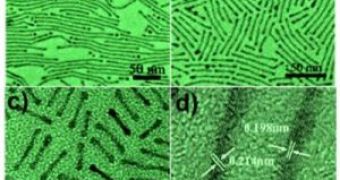Iron-platinum nanorods and nanowires could one day find practical applications in compressed, thus more effective computer memory devices. Building them with uniform shape and magnetic alignment is a key element in creating the next generation of high-density information storage applications.
So, far, controlling the size and composition of these nanostructures has been hard to achieve in bulk, but now, a team of chemists at Brown University has devised a simple way to do just that.
Shouheng Sun, a professor of chemistry at Brown University, postdoctoral researcher Yanglong Hou and colleagues were successful in creating nanorods and nanowires from 20 nm to 200 nm long, simply by varying the ratio of solvent and surfactant used in synthesis.
Their new method could even work for many other combinations, as well. This will soon prove very useful, as silicon-based computing technology seems to have reached the maximum limit of miniaturization.
One of the problems that stood in the way of getting more information density on nanoscale devices was the difficulty of making the tiny magnetic particles to align with each other. The two scientists think they can use particle shape to do the job.
"Many people think that shape can control alignment," said Sun, "but controlling shape has not been so easy. This method gives us a really simple way to tune length, diameter and composition all at the same time."
The disks on a HDD are made of tiny sectors of magnetically-aligned particles. A read-write head of the disk passes over a sector, flipping the magnetic field to the opposite direction and thus encoding a zero or a one. By making the particles smaller or the sectors smaller, more information could be packed on a smaller area.
The new method is creating a method of doing that, by packing long and narrow nanorods alongside each other, with their magnetic fields oriented in only two directions, which could produce a stronger signal and switch cleanly from zero to one and vice versa.
The stability and biocompatibility of the iron-platinum alloy also make such nanorods and nanowires good candidates for biological applications.

 14 DAY TRIAL //
14 DAY TRIAL //